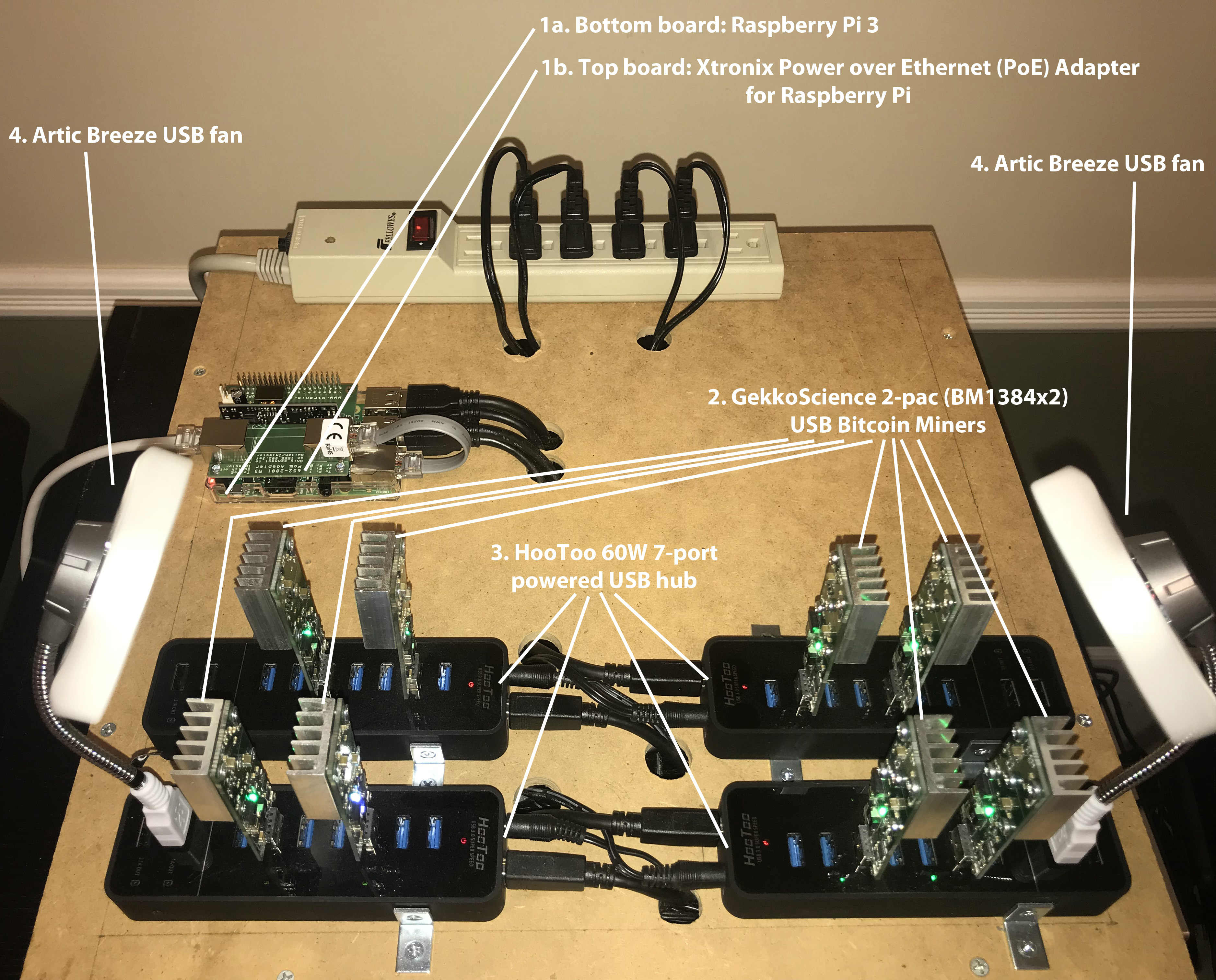Bitcoin Mining: Six Months Later
By Jim Connors 28 February 2018
About six months have passed since first setting up a personal
Bitcoin mining rig. As a follow up to that original post, I
thought it make make sense to return to see what's transpired
during this brief -- and tumultuous -- period, and to discuss
adjustments made to the rig.
What's Changed in the Bitcoin
Universe?
My Humble Bitcoin Mining Rig (version 2.0)
Configuration Changes
Return on Investment? Really?
What's Changed in the Bitcoin Universe?
In a word, a lot (actually that's two words, but who's counting).
Here are just a few trends:
My Humble Bitcoin Mining Rig (version 2.0)
Here's what the new version of the rig looks like. The
original rig can be viewed here.
Following is a description of the modifications.

- Raspberry Pi 3: Even with the new and
improved hash rate this rig provides, the Raspberry Pi 3 still
has more than enough horsepower to serve as the overall
controller. The big change to the controller involves the
addition of the Xtronix
Power over Ethernet (PoE) Adapter for the Raspberry Pi.
With PoE, it's now possible to remotely reset the power on this
rig. In the Configuration Changes section of
this article, software modifications have been made which make
this platform much more reliable. Nonetheless, the ability
to remotely hard reset the rig does come in handy occasionally.
- GekkoScience 2-pac (BM 1348x2) USB Bitcoin Miners:
The number of USB ASIC miners has been doubled from 4 to
8. Running at 225Mhz, this rig now averages about 200 Gh/s
(200 Billion hashes per second). The power consumption
stands at about 100 Watts, roughly equivalent to an old school
incandescent light bulb.
- HooToo 60W 7-port powered USB hubs: To
accommodate the additional USB ASIC miners, two USB hubs have
been added. All four USB ports on the Raspberry Pi 3 are
now occupied.
- Artic Breeze USB fans: An extra USB fan was
added to assure all miners are cooled adequately.
Configuration Changes
After running without incident for weeks, the Raspberry Pi began
occasionally locking up, rendering it unusable until a hard reset
was performed. A search yielded this thread,
where it appears others were experiencing similar problems.
Related to kernel memory corruption, a two-fold solution was
employed to minimize the downtime associated with this tricky
problem:
- Enable SLUB
debugging in the Raspian kernel. Although this
requires the Linux kernel to consume more CPU cycles, a large
number of these intermittent memory allocation errors will be
caught. In order to configure and enable SLUB debugging,
as root add the following line to the /boot/cmdline.txt
file: slub_debug=FPUZ and reboot.
- Configure in a watchhdog daemon. Many processors come
equipped with a watchdog timer which simply counts down from
some set value to zero. In order to prevent it from
reaching zero, the system must periodically reset the watchdog
timer. If the timer reaches zero, it is assumed the
system has hung. The watchdog daemon detects this
condition and can be configured to reboot when this occurs,
lessening the need for manual intervention. This procedure
is typically hardware, Operating System and version
dependent. One way to enable the watchdog reset feature
for a Raspberry Pi 3 running Raspbian Jessie is to follow
these instructions.
Return on Investment? Really?
Even though the price of Bitcoin has risen by about 2½
times its September 2017 value and my mining rig has doubled in
capacity, those substantial gains cannot offset the tremendous
increase in worldwide mining capacity. Taking this
point-in-time analysis with a grain of salt, the average current
daily yield in Bitcoins for my rig (as of 26-Feb-2018) is
.00001677. Multiplied by the current price ($10,158 US)
results in a daily reward of $0.17 US a day. That's two
cents a day more than the original setup but with double the power
requirements (100 Watts vs. 50 Watts), not to mention the capital
costs of the additional equipment. So to repurpose the punchline
from an old joke: "we're losing money on every transaction and
making it up in volume".

